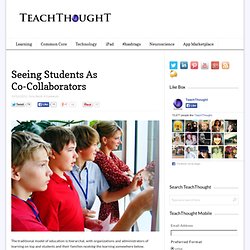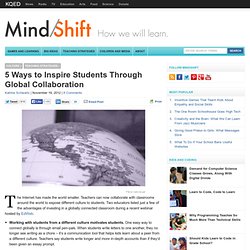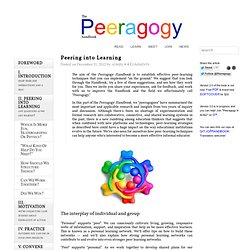

The 7 Styles Of Learning: Which Works For You? Facilitating Collaborative Learning: 20 Things You Need to Know From the Pros. Seeing Students As Co-Collaborators. The traditional model of education is hierarchal, with organizations and administrators of learning on top and students and their families receiving the learning somewhere below.

While this made sense in the past when public education–inclusive systems of public education at that—were still finding their way, there is little excuse for such a workflow as we approach 2013. Embedded in this simple pattern are troubling implications that sabotage learning processes from the beginning. In informal and as they occur learning circumstances, the concept of power and currency is highly dynamic, constantly shifting based on context.
If you are researching for the best fix for a leaking roof or an injured lower back, you might seek experts, or demonstrated expertise. That is, someone that can directly help, or some published media that might inform you. In formal learning settings, this is all turned on its head. 5 Ways to Inspire Students Through Global Collaboration. Culture Teaching Strategies Flickr:rwkvisual The Internet has made the world smaller.

Teachers can now collaborate with classrooms around the world to expose different culture to students. Two educators listed just a few of the advantages of investing in a globally connected classroom during a recent webinar hosted by EdWeb. Working with students from a different culture motivates students. International pen pals may be the most straightforward global collaboration available. Epals is a free resource that allows educators to easily find other classrooms interested in collaborations. Peering Into Learning. The aim of the Peeragogy Handbook is to establish effective peer-learning techniques that you can implement “on the ground.”

We suggest that you look through the Handbook, try a few of these suggestions, and see how they work for you. Then we invite you share your experiences, ask for feedback, and work with us to improve the Handbook and the field we affectionately call “Peeragogy.”In this part of the Peeragogy Handbook, we “peeragogues” have summarised the most important and applicable research and insights from two years of inquiry and discussion. Although there’s been no shortage of experimentation and formal research into collaborative, connective, and shared learning systems in the past, there is a new rumbling among education thinkers that suggests that when combined with new platforms and technologies, peer-learning strategies as described here could have a huge impact on the way educational institutions evolve in the future.
Yrittäjyyskasvatuksen oppijalähtöinen pedagogiikka. 30 Surprising (And Controversial) Ways Students Learn. Have you checked your assumptions about student learning at the door? People in general, hold onto beliefs that are shaped by early experiences, the media, and faulty influences. The following list is a compilation of research that may surprise you. Video games, e-books, playtime, and music are all a part of an educator’s repertoire. Read on, and be prepared to put your traditional beliefs aside as science points to innovative methods that indicate future success. 1. Until recently, studies done with regards to children and video games usually centered on the negative impacts and consequences of prolonged use. She recognized several social motivations for playing video games including competition, a reason to hang out and casually converse with friends, and teaching peers how to play a game.
In boys who struggle with stress, fear, and anger- negative emotions that can have violent consequences- video games acted as a safe alternative for the release of pent up emotion. 2. 3. 4. Patrick S. Best and Worst Learning Strategies: Why Highlighting is a Waste of Time. In a world as fast-changing and full of information as our own, every one of us — from schoolchildren to college students to working adults — needs to know how to learn well.

Yet evidence suggests that most of us don’t use the learning techniques that science has proved most effective. Worse, research finds that learning strategies we do commonly employ, like rereading and highlighting, are among the least effective. (MORE: How to Use Technology to Make You Smarter) The scientific literature evaluating these techniques stretches back decades and across thousands of articles.
It’s far too extensive and complex for the average parent, teacher or employer to sift through. The WorstHighlighting and underlining led the authors’ list of ineffective learning strategies. The BestIn contrast to familiar practices like highlighting and rereading, the learning strategies with the most evidence to support them aren’t well known outside the psych lab.